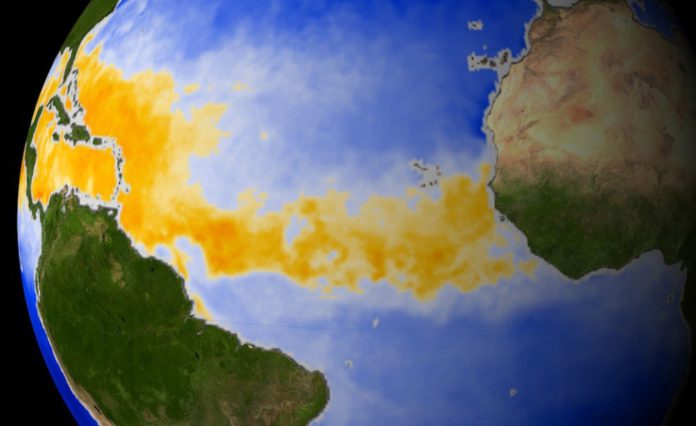New Delhi, Feb 9 (NVI) As many as 3.6 billion people are living in areas highly susceptible to climate change and between 2030 and 2050, climate change is expected to cause approximately 250 000 additional deaths per year, from undernutrition, malaria, diarrhoea and heat stress alone, according to the World Health Organisation (WHO).
According to the WHO, climate change is directly contributing to humanitarian emergencies from heatwaves, wildfires, floods, tropical storms and hurricanes and they are increasing in scale, frequency and intensity.
The direct damage costs to health (excluding costs in health-determining sectors such as agriculture and water and sanitation) is estimated to be between US$ 2–4 billion per year by 2030, it says.
Areas with weak health infrastructure – mostly in developing countries – will be the least able to cope without assistance to prepare and respond, the global health body says.
Reducing emissions of greenhouse gases through better transport, food and energy use choices can result in very large gains for health, particularly through reduced air pollution.
The 6th Assessment Report of Intergovernmental Panel on Climate Change has concluded that climate risks are appearing faster and will become more severe sooner than previously expected, and it will be harder to adapt with increased global heating, the WHO says.
It further reveals that 3.6 billion people already live in areas highly susceptible to climate change. Despite contributing minimally to global emissions, low-income countries and small island developing states (SIDS) endure the harshest health impacts.
In vulnerable regions, the death rate from extreme weather events in the last decade was 15 times higher than in less vulnerable ones, the WHO says.
Climate change is impacting health in a myriad of ways, including by leading to death and illness from increasingly frequent extreme weather events, such as heatwaves, storms and floods, the disruption of food systems, increases in zoonoses and food-, water- and vector-borne diseases, and mental health issues.
Furthermore, climate change is undermining many of the social determinants for good health, such as livelihoods, equality and access to health care and social support structures.
These climate-sensitive health risks are disproportionately felt by the most vulnerable and disadvantaged, including women, children, ethnic minorities, poor communities, migrants or displaced persons, older populations, and those with underlying health conditions.
An overview of climate-sensitive health risks, their exposure pathways and vulnerability factors. Climate change impacts health both directly and indirectly, and is strongly mediated by environmental, social and public health determinants.
Although it is unequivocal that climate change affects human health, it remains challenging to accurately estimate the scale and impact of many climate-sensitive health risks.
However, scientific advances progressively allow us to attribute an increase in morbidity and mortality to global warming, and more accurately determine the risks and scale of these health threats, the global body says.
WHO data indicates 2 billion people lack safe drinking water and 600 million suffer from foodborne illnesses annually, with children under 5 bearing 30% of foodborne fatalities. Climate stressors heighten waterborne and foodborne disease risks.
In 2020, 770 million faced hunger, predominantly in Africa and Asia. Climate change affects food availability, quality and diversity, exacerbating food and nutrition crises.
Temperature and precipitation changes enhance the spread of vector-borne diseases. Without preventive actions, deaths from such diseases, currently over 700 000 annually, may rise. Climate change induces both immediate mental health issues, like anxiety and post-traumatic stress, and long-term disorders due to factors like displacement and disrupted social cohesion.
Recent research attributes 37% of heat-related deaths to human-induced climate change. Heat-related deaths among those over 65 have risen by 70% in two decades.
In 2020, 98 million more experienced food insecurity compared to the 1981–2010 average.
The WHO conservatively projects 250 000 additional yearly deaths by the 2030s due to climate change impacts on diseases like malaria and coastal flooding. However, modelling challenges persist, especially around capturing risks like drought and migration pressures.
The climate crisis threatens to undo the last 50 years of progress in development, global health and poverty reduction, and to further widen existing health inequalities between and within populations.
It severely jeopardizes the realization of UHC in various ways, including by compounding the existing burden of disease and by exacerbating existing barriers to accessing health services, often at the times when they are most needed.
Over 930 million people – around 12% of the world’s population – spend at least 10% of their household budget to pay for health care.
With the poorest people largely uninsured, health shocks and stresses already currently push around 100 million people into poverty every year, with the impacts of climate change worsening this trend.
In the short- to medium-term, the health impacts of climate change will be determined mainly by the vulnerability of populations, their resilience to the current rate of climate change and the extent and pace of adaptation, the global body says.
In the longer-term, the effects will increasingly depend on the extent to which transformational action is taken now to reduce emissions and avoid the breaching of dangerous temperature thresholds and potential irreversible tipping points, it says.
While no one is safe from these risks, the people whose health is being harmed first and worst by the climate crisis are the people who contribute least to its causes, and who are least able to protect themselves and their families against it: people in low-income and disadvantaged countries and communities, the WHO says.
Addressing climate change’s health burden underscores the equity imperative: those most responsible for emissions should bear the highest mitigation and adaptation costs, emphasizing health equity and vulnerable group prioritization. (NVI)









[…] NOTE – This article was originally published in newsvibesofindia and can be viewed here […]